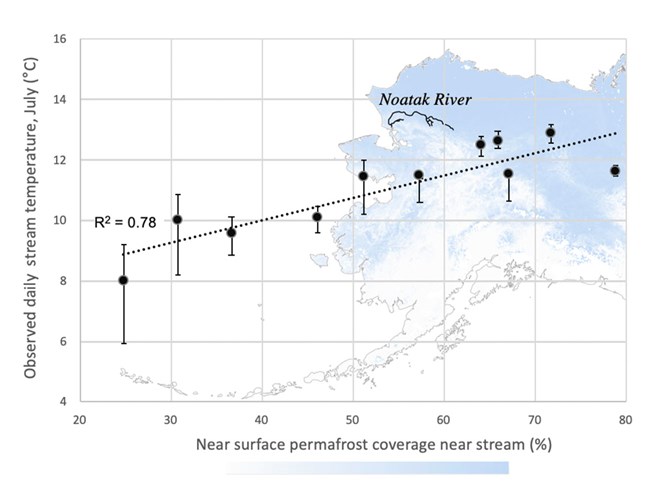Last updated: February 23, 2021
Article
Stream water may become cooler as permafrost thaws in the Arctic

USGS/Joshua Koch
Permafrost is a unique and important feature of Arctic landscapes, influencing hydrology and biogeochemical cycling across the region. The presence of permafrost influences groundwater flow through soils, and as a result, can determine stream flow and temperature. Recent warming in the Arctic is driving permafrost thaw, which can dramatically alter the hydrology of watersheds. While many research advances have been made in recent years, the hydrology of thawing permafrost terrain is complicated and difficult to measure and observe. In this study, we combined field observations and modeling to explore how permafrost governs the relationship between groundwater flow and stream temperature. We monitored temperature across 11 headwater streams in Noatak National Preserve in northwest Alaska. To our surprise, we found that summer stream temperatures were warmer in watersheds with more permafrost near the ground surface.

To better understand the reasons for this observation, we used a model to simulate the depth and temperature of groundwater flowing along Arctic hillslopes with different permafrost properties. Our model results showed that along hillslope with continuous permafrost coverage, groundwater flows mainly through relatively warm, shallow soil horizons. Along hillslopes with no permafrost, groundwater flows through deeper, colder soil horizons prior to entering the stream. Overall, this study suggests that as permafrost thaws, stream water temperatures in the summer may become cooler due to these shifts in groundwater flow. This finding has important implications for stream biota, including fish, which are very sensitive to changing temperatures in the Arctic.

These results are from the Hydro-Ecology of Arctic Thawing project, with the overall goal of understanding how warming and thawing of the Arctic impact stream hydrology, biogeochemistry, ecosystems, and fish. Our work takes place in the Arctic Network Parks because they lie in a region that is rapidly warming. We focus on headwater streams because they are more susceptible to hydrologic changes than larger rivers, control the flux of solutes and nutrients from the land to rivers and the ocean, and provide critical habitat and food resources to juvenile fish. This work is joint effort of the US Geological Survey Alaska Science Center, the National Park Service, and the Department of Energy Oak Ridge National Laboratory. See more on climate and lost permafrost.
Permafrost promotes shallow groundwater flow and warmer headwater streams
Abstract
The presence of permafrost influences the flow paths of water through Arctic landscapes and thereby has the potential to impact stream discharge and thermal regimes. Observations from eleven headwater streams in Alaska showed that July water temperatures were higher in catchments with more near‐surface permafrost. We apply a fully coupled cryohydrology model to investigate if the impact of permafrost on flow path depth could cause the same pattern in temperatures of groundwater discharging from hillslopes to streams. The model simulates surface energy and water balances, snow, and subsurface water and energy balances for two‐dimensional hillslope model cases with varying permafrost extent. We find that hillslopes with continuous permafrost have more shallow flow paths and twice as high rates of evapotranspiration, compared to hillslopes with no permafrost. For our simulated cases, 6.7 % of the horizontal water flux moves through the top organic soil layers when there is continuous permafrost, while only 0.5 % moves through organic layers without permafrost. The deeper flow paths in permafrost‐free simulations buffer seasonal temperature extremes, so that summer groundwater discharge temperatures are highest with continuous permafrost. Our results suggest that permafrost thawing alters groundwater flow paths and can lead to decreases in summer stream temperatures and reductions in evapotranspiration in headwater catchments. These changes are of potential importance for stream biotic components of ecosystems, however, the full impact remains unknown.
Sjöberg, Y., A. Jan, S. L. Painter, E. T. Coon, M. P. Carey, J. A. O'Donnell, and J. C. Koch. 2021. Permafrost promotes shallow groundwater flow and warmer headwater streams. Water Resources Research 57(2): e2020WR027463.
